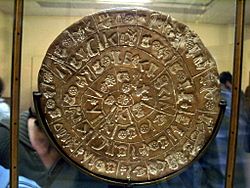Cretan hieroglyphs facts for kids
Cretan heiroglyphs is a writing system, used in Crete from about the 20th to the 15th century BC. It is undeciphered, so it cannot be read today. For most of its history, it was used together with Linear A. Most symbols are pictograms, for some symbols, experts do not agree on what they represent. Most of the corpus consists of short inscriptions on seal stones, and clay tablets. The texts are usually very short, they are inscriptions on seals, and markers on clay tablets. There are three items that are noticeably different: A stone called Malia altar stone, the Phaistos Disc and the Arkalochori Axe. The exact relation of these items to the rest of the corpus is unknown.
In total, there are 137 symbols. 96 seem to be words, or part of words. 32 are probably Logograms. 9 seem to represent fractions. There are four numerals, standing for 1, 10, 100 and 1000. One symbol is used to separate words, like a hyphen, another looks like a cross, and probably stands for the beginning of the text. The writing is probably syllabic.
- J. G. Younger: The Cretan Hieroglyphic Script: A Review Article; Minos 31–32 (1996–1997), pp 379–400.
Images for kids
-
Cretan hieroglyphs (1900–1600 BC) on a clay bar from Malia or Knossos, Crete. As exhibited at Heraklion Archaeological Museum, Crete, Greece. Dots represent numerals
See also
 In Spanish: Jeroglífico cretense para niños
In Spanish: Jeroglífico cretense para niños



